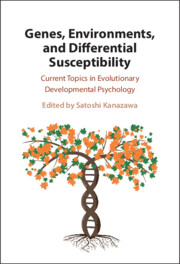 Genes, Environments, and Differential Susceptibility
Genes, Environments, and Differential Susceptibility Book contents
- Genes, Environments, and Differential Susceptibility
- Genes, Environments, and Differential Susceptibility
- Copyright page
- Contents
- Figures
- Tables
- Contributors
- Introduction
- Part I Historical Background and Theoretical Foundations of Jay Belsky’s Work in Evolutionary Developmental Psychology
- Chapter 1 How Belsky’s Model of Child Abuse Has Transformed Scientific Understanding, Clinical Practice, and Public Policy
- Chapter 2 A Turning Point for the Life History Approach to Individual Differences
- Chapter 3 Individual Differences in Response to the Environment
- Part II Parent–Child Relations and Attachment
- Part III Life-Course Development from Prenatal Environment through Childhood to Adulthood
- Part IV Differential Susceptibility to Environmental Influences
- Conclusion
- Afterword
- Biography of Jay Belsky
- Index
- References
Chapter 3 - Individual Differences in Response to the Environment
From Diathesis-Stress to Differential Susceptibility and Vantage Sensitivity
from Part I - Historical Background and Theoretical Foundations of Jay Belsky’s Work in Evolutionary Developmental Psychology
Published online by Cambridge University Press: 04 September 2025
- Genes, Environments, and Differential Susceptibility
- Genes, Environments, and Differential Susceptibility
- Copyright page
- Contents
- Figures
- Tables
- Contributors
- Introduction
- Part I Historical Background and Theoretical Foundations of Jay Belsky’s Work in Evolutionary Developmental Psychology
- Chapter 1 How Belsky’s Model of Child Abuse Has Transformed Scientific Understanding, Clinical Practice, and Public Policy
- Chapter 2 A Turning Point for the Life History Approach to Individual Differences
- Chapter 3 Individual Differences in Response to the Environment
- Part II Parent–Child Relations and Attachment
- Part III Life-Course Development from Prenatal Environment through Childhood to Adulthood
- Part IV Differential Susceptibility to Environmental Influences
- Conclusion
- Afterword
- Biography of Jay Belsky
- Index
- References
Summary
The notion that individuals differ in their response to environmental influences has become an important concept in the field of psychology. Since Belsky’s first proposition – based on evolutionary considerations – that individuals might vary in their susceptibility to their rearing environment, similar theories emerged and the last thirty years have seen a steady increase of empirical work confirming differential susceptibility. In this chapter, I am reviewing the development of Belsky’s differential susceptibility hypothesis including consideration of early precursors of individual differences in environmental sensitivity, and the development and contribution of diathesis-stress as well as vantage sensitivity. After summarising the current state of knowledge, several outstanding questions are discussed. This chapter concludes that Belsky’s notion of differential susceptibility has led to a paradigm shift in the field of developmental psychology and represents an example of how application of evolutionary theory can innovate and advance knowledge in psychology.
Information
- Type
- Chapter
- Information
- Genes, Environments, and Differential SusceptibilityCurrent Topics in Evolutionary Developmental Psychology, pp. 58 - 80Publisher: Cambridge University PressPrint publication year: 2025
References
Accessibility standard: WCAG 2.0 A
Why this information is here
This section outlines the accessibility features of this content - including support for screen readers, full keyboard navigation and high-contrast display options. This may not be relevant for you.Accessibility Information
Content Navigation
Allows you to navigate directly to chapters, sections, or non‐text items through a linked table of contents, reducing the need for extensive scrolling.
Provides an interactive index, letting you go straight to where a term or subject appears in the text without manual searching.
Reading Order & Textual Equivalents
You will encounter all content (including footnotes, captions, etc.) in a clear, sequential flow, making it easier to follow with assistive tools like screen readers.
You get concise descriptions (for images, charts, or media clips), ensuring you do not miss crucial information when visual or audio elements are not accessible.
You get more than just short alt text: you have comprehensive text equivalents, transcripts, captions, or audio descriptions for substantial non‐text content, which is especially helpful for complex visuals or multimedia.
Visual Accessibility
You will still understand key ideas or prompts without relying solely on colour, which is especially helpful if you have colour vision deficiencies.
You benefit from high‐contrast text, which improves legibility if you have low vision or if you are reading in less‐than‐ideal lighting conditions.